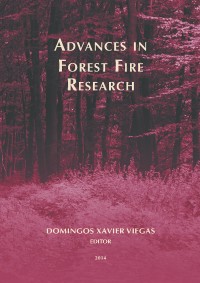Please use this identifier to cite or link to this item:
https://hdl.handle.net/10316.2/34154| Title: | Wildfires in Mediterranean shrubs and grasslands, in Greece: in situ fire behaviour observations versus predictions | Authors: | Athanasiou, Miltiadis Xanthopoulos, Gavriil |
Keywords: | Mediterranean shrubs;maquis;phrygana;fuel model;wildfire behaviour prediction;BehavePlus;wildfire field observations;Greece | Issue Date: | 2014 | Publisher: | Imprensa da Universidade de Coimbra | Journal: | http://hdl.handle.net/10316.2/34013 | Abstract: | This paper presents a testing of surface wildfire rate of spread (ROS) field observations (ROSobserved(surface)) versus rate of spread predictions (ROSpredicted(surface)) from BehavePlus (Andrews et al., 2005) for tall and short Mediterranean shrublands, Sarcopoterium spinosum (small xeric shrub, up to 0.5 m height) and grass. In order to evaluate the degree of their agreement and analyse the results of their correlations, surface or passive crown fire behaviour data as well as meteorological, topography and forest fuels data had to be prepared according to specific criteria in order to ensure their quality and compatibility. Ninety five fire behaviour data records were created from field observations and measurements made during the evolution of specific wildfires in Greece, in the last seven fire seasons (2007-2013). The data were classified depending on the fuel model that describes the fuel types they had spread in and, thus, four data subsets were generated that correspond to the following four fuel models for Greece which had been developed in 2001 (Dimitrakopoulos et al 2001, Dimitrakopoulos 2002): a) “Evergreen-schlerophyllous shrublands (1.5 - 3 m)” for tall maquis (38 cases), b) “Evergreen schlerophyllous shrublands (up to 1.5 m)” for short maquis (13 cases), c) “Phrygana II (Sarcopoterium spinosum)” for phryganic areas where the dominant species was Sarcopoterium spinosum (26 cases) and d) “Mediterranean grasslands” for grass (18 cases). After creating the database, the BehavePlus system was used to produce rate of spread predictions for each of the ninety five cases and flame length (FL) predictions (FLpredicted values) for the twenty six cases of Sarcopoterium spinosum dominated phrygana fields. The main finding is that for the four Greek fuel models tested, BehavePlus can be a useful tool for predictions of fire behaviour. However, there is a relatively consistent over-prediction of ROS for the models “Evergreen-schlerophyllous shrublands (1.5 - 3 m)” for tall maquis, “Evergreen schlerophyllous shrublands (up to 1.5 m)” for short maquis (13 cases), and “Phrygana II (Sarcopoterium spinosum)”, while there a significant under-prediction for the “Mediterranean grasslands” fuel model. Four linear regression equations describing mathematically the relation of the predicted to the observed ROS were developed. They are statistically significant and can be used for adjusting BehavePlus predictions to match “real world” fire behaviour. A further finding was that flame length is seriously under-predicted when using BehavePlus with the Phrygana II fuel model to predict fire behaviour in Sarcopoterium spinosum dominated phrygana fields. This is an important result that can be very useful for the safety of firefighters | URI: | https://hdl.handle.net/10316.2/34154 | ISBN: | 978-989-26-0884-6 (PDF) | DOI: | 10.14195/978-989-26-0884-6_56 | Rights: | open access |
| Appears in Collections: | Advances in forest fire research |
Files in This Item:
| File | Description | Size | Format | |
|---|---|---|---|---|
| 978-989-26-0884-6_56.pdf | 2.43 MB | Adobe PDF |  |
Items in DSpace are protected by copyright, with all rights reserved, unless otherwise indicated.
